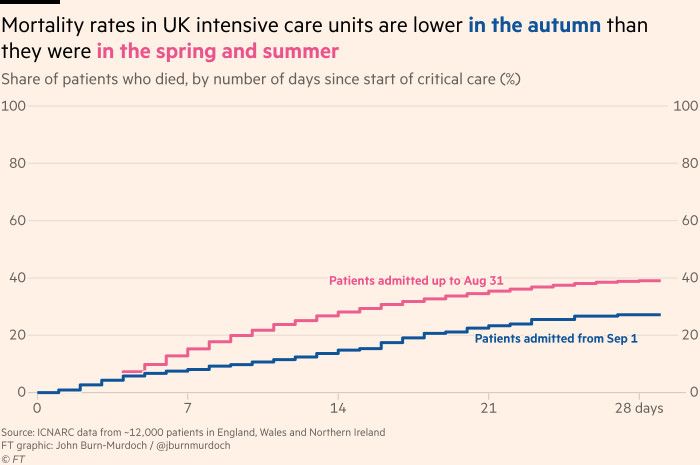While coronavirus infections have been surging again across Europe since late summer, the chances of surviving the respiratory disease seem to have improved from the first phase of the outbreak.
虽然自夏末以来欧洲各地的新型冠状病毒肺炎(COVID-19,即2019冠状病毒病)感染人数再次激增,但与第一波疫情相比,这种呼吸系统疾病患者的存活率似乎有所提高。
The number of Covid-19 patients ill enough to go to hospital has risen less steeply — and mortality more slowly still, according to an FT analysis. Health services are not overwhelmed as they would have been if severe disease had followed infection in the way it did between March and April.
英国《金融时报》的一项分析显示,病情严重到需住院治疗的新冠患者人数的上升速度有所趋缓——死亡率上升速度则更加缓慢。医疗系统并未被压垮,如果这波感染像今年三四月那样带来那么多重症患者的话,医疗系统很可能会不堪重负。
“In western Europe, pretty much every country including the UK is still seeing a much smaller per capita death rate in this second wave than in the first one during the spring,” said Mark Woolhouse, professor of infectious disease epidemiology at the University of Edinburgh.
爱丁堡大学(University of Edinburgh)传染病流行病学教授马克•伍尔豪斯(Mark Woolhouse)表示:“在包括英国在内的几乎所有西欧国家,第二波疫情期间的人均死亡率仍远低于春季第一波疫情期间的水平。”
The falling “case fatality rate” — deaths as a proportion of confirmed cases — can be explained partly by increased testing, which reveals more infections, and by the fact that a higher percentage of people with Covid-19 today are young and less likely to become severely ill than patients in the spring.

But even patients admitted to critical care are more likely to survive now than their counterparts earlier in the pandemic. Data from ICNARC, the UK Intensive Care National Audit and Research Centre, show that the proportion who died within 28 days of admission fell from 39 per cent in the months to August 31, to 27 per cent after September 1.
“病死率”(死亡数在确诊病例中的比例)下降的部分原因是扩大的检测发现了更多感染病例,以及在目前的新冠患者中,年轻人的比例更高——与今春时期的患者相比,年轻患者更少发展成重症。